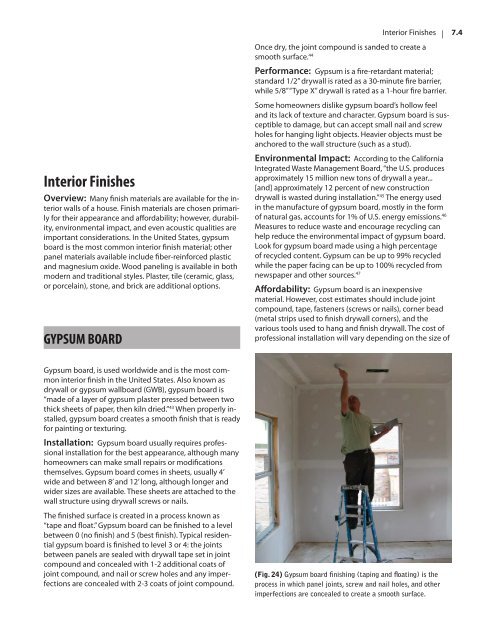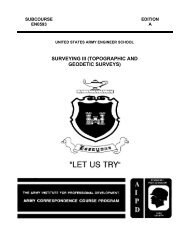Alternative Construction Research Guide - GCCDS
Alternative Construction Research Guide - GCCDS
Alternative Construction Research Guide - GCCDS
Create successful ePaper yourself
Turn your PDF publications into a flip-book with our unique Google optimized e-Paper software.
Interior FinishesOverview: Many finish materials are available for the interiorwalls of a house. Finish materials are chosen primarilyfor their appearance and affordability; however, durability,environmental impact, and even acoustic qualities areimportant considerations. In the United States, gypsumboard is the most common interior finish material; otherpanel materials available include fiber-reinforced plasticand magnesium oxide. Wood paneling is available in bothmodern and traditional styles. Plaster, tile (ceramic, glass,or porcelain), stone, and brick are additional options.GYPSUM BOARDInterior Finishes | 7.4Once dry, the joint compound is sanded to create asmooth surface. 44Performance: Gypsum is a fire-retardant material;standard 1/2” drywall is rated as a 30-minute fire barrier,while 5/8” “Type X” drywall is rated as a 1-hour fire barrier.Some homeowners dislike gypsum board’s hollow feeland its lack of texture and character. Gypsum board is susceptibleto damage, but can accept small nail and screwholes for hanging light objects. Heavier objects must beanchored to the wall structure (such as a stud).Environmental Impact: According to the CaliforniaIntegrated Waste Management Board, “the U.S. producesapproximately 15 million new tons of drywall a year...[and] approximately 12 percent of new constructiondrywall is wasted during installation.” 45 The energy usedin the manufacture of gypsum board, mostly in the formof natural gas, accounts for 1% of U.S. energy emissions. 46Measures to reduce waste and encourage recycling canhelp reduce the environmental impact of gypsum board.Look for gypsum board made using a high percentageof recycled content. Gypsum can be up to 99% recycledwhile the paper facing can be up to 100% recycled fromnewspaper and other sources. 47Affordability: Gypsum board is an inexpensivematerial. However, cost estimates should include jointcompound, tape, fasteners (screws or nails), corner bead(metal strips used to finish drywall corners), and thevarious tools used to hang and finish drywall. The cost ofprofessional installation will vary depending on the size ofGypsum board, is used worldwide and is the most commoninterior finish in the United States. Also known asdrywall or gypsum wallboard (GWB), gypsum board is“made of a layer of gypsum plaster pressed between twothick sheets of paper, then kiln dried.” 43 When properly installed,gypsum board creates a smooth finish that is readyfor painting or texturing.Installation: Gypsum board usually requires professionalinstallation for the best appearance, although manyhomeowners can make small repairs or modificationsthemselves. Gypsum board comes in sheets, usually 4’wide and between 8’ and 12’ long, although longer andwider sizes are available. These sheets are attached to thewall structure using drywall screws or nails.The finished surface is created in a process known as“tape and float.” Gypsum board can be finished to a levelbetween 0 (no finish) and 5 (best finish). Typical residentialgypsum board is finished to level 3 or 4: the jointsbetween panels are sealed with drywall tape set in jointcompound and concealed with 1-2 additional coats ofjoint compound, and nail or screw holes and any imperfectionsare concealed with 2-3 coats of joint compound.(Fig. 24) Gypsum board finishing (taping and floating) is theprocess in which panel joints, screw and nail holes, and otherimperfections are concealed to create a smooth surface.
















